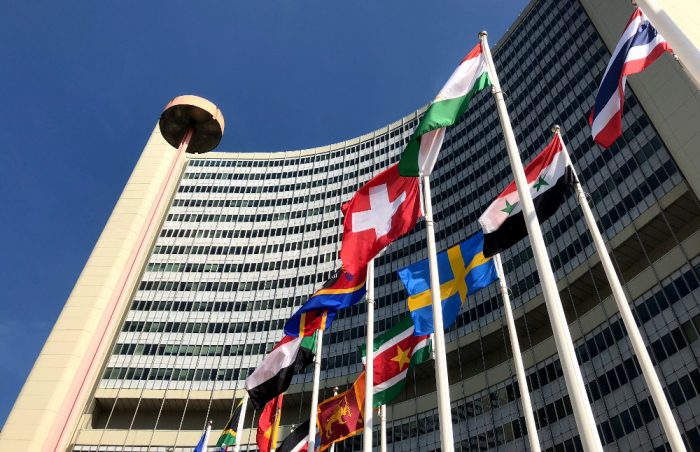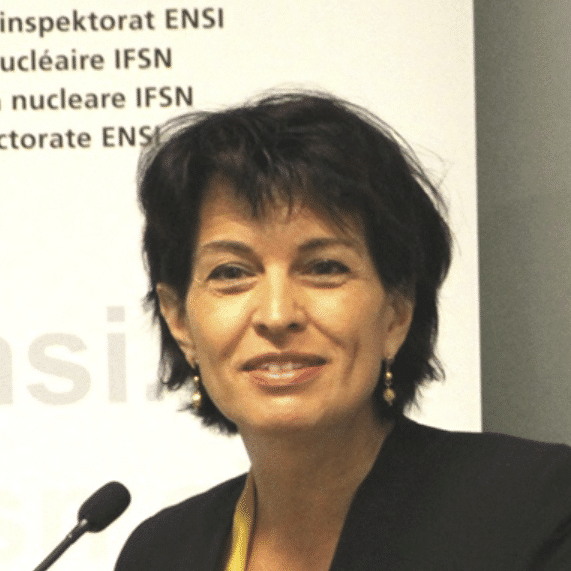Ten Years on from Fukushima (5/6): Switzerland’s International Position

After the accident at Fukushima, there was an increasing demand for international safety standards and their international monitoring. Switzerland, and in particular ENSI, was committed to mandatory backfitting on a global basis. Even if such safety principles are still not legally binding, the reactor accident acted as a booster for a new safety awareness amongst the international community.
In the wake of the accident at Fukushima Daiichi, nearly every country has been carefully re-examining its nuclear regulation, and, in some cases, has decided on changing their respective energy policies. Switzerland too set the seal on its exit from nuclear energy – even if the existing nuclear power plants (NPPs) can continue operating for as long as they remain safe. Nevertheless, nuclear safety is not just a national concern. Regulators and politicians worldwide have been wondering how the accident in Fukushima could have been prevented. As the 2011 reactor accident was reappraised, international cooperation grew in importance.
Ministerial Conference: safety review based on international oversight
A first Ministerial Conference took place on 7 and 8 June 2011 in Paris. The then Federal Councillor, Doris Leuthard first asked, as Switzerland’s representative, for the events in Japan to be analysed by experts of the Nuclear Energy Agency (NEA) in cooperation with the International Atomic Energy Agency (IAEA) and secondly asked for international experts to review the safety of NPPs in the future.
In Paris, the 30 contracting states supported the examination of the legal bases in the individual countries, in particular in respect of the independence of the regulators, the safety of nuclear power plant operation and the design of nuclear power plants in the face of extreme natural hazards, especially earthquakes and flooding.
IAEA safety standards: trigger for national regulations
The IAEA called a ministerial conference for the end of June. The conference discussed the events at Fukushima: What lessons could the international community learn from the events and how could the international regulatory framework for nuclear safety be improved?
In the wake of Fukushima, Switzerland had repeatedly called for systematic international safety reviews to be made mandatory, following the pattern of peer reviews already existing in Switzerland. However the IAEA Board of Governors in Vienna only called for the international expert missions to be implemented on a voluntary basis. Switzerland criticised this reticence in the face of the two fateful reactor accidents at Chernobyl and Fukushima. Both the reactor accident in Chernobyl in 1986 and that of Fukushima were rated Level 7 and thus as a major accident on the international nuclear event scale.
ENSI’s engagement within WENRA: the reaction to the reactor accident
In November 2011, the members or the Western European Nuclear Regulators Association (WENRA) named then ENSI Director Hans Wanner as their new Chairman. As the association of the heads of the nuclear regulators, WENRA is one of the leading international organisations for nuclear safety. Amongst other things, it was responsible for shaping the standards for the EU stress test, see also ‘Ten Years on from Fukushima (3/6): The EU Stress Test’. WENRA’s main duty is to harmonise and improve safety standards in the areas of reactor safety, decommissioning and nuclear waste disposal. Switzerland is represented by ENSI within WENRA.
After the reactor accident in Fukushima, WENRA analysed the lessons learned and revised the safety requirements. In doing so the recommendations of the European Nuclear Safety Regulators Group ENSREG were also taken into account – ranging from the preparation of European guidelines for the assessment of natural hazards, through to the backfitting of emergency systems, including the updating of alarm and instrumentation systems. In the Reactor Harmonisation Working Group RHWG, Switzerland actively participated in the revision of the safety reference levels for nuclear power plants.
Changes to the WENRA safety reference levels particularly concerned ‘Protection against beyond design-basis accidents’ and ‘Extreme natural events’. Amongst other things, design extension conditions have extended the precautionary design range to very unlikely conditions, also referred to as beyond design-basis accidents.
“In recent years we have achieved a great deal, such as the revised safety reference levels after the Fukushima accident,” said then ENSI Director and WENRA Chairman Hans Wanner. “Thus, in accordance with WENRA’s objectives, it was possible to further harmonise and strengthen nuclear safety in Europe.”
Backfitting philosophy: “No easy way” to international commitment
In respect of the extraordinary review meeting on the Convention on Nuclear Safety, CNS, in August 2012, Switzerland proposed improvements to the international convention and its processes. The Swiss amendments did not achieve a consensus at the time and were therefore not adopted. Instead, a working group was set up to draw up proposals to strengthen the Convention and its processes. The working group’s proposals included numerous measures for improving transparency, in particular with regard to the drafting of the national reports, and a proposal to amend the CNS.
This amendment was submitted by Switzerland to the CNS: new nuclear power plants should be built based on the latest safety standards and technologies. The safety of existing nuclear power plants should be based on these benchmarks and should be continuously improved. The proposed amendment was discussed at the 2014 review meeting in Vienna. In the final vote, the Swiss amendment received the necessary two-thirds majority to convene a diplomatic conference.
“Switzerland had a hard job of time persuading people. At the same time, it was clear to all countries that, in the wake of the Fukushima reactor accident, business as usual was not an option without presenting a strong international response.”
Rolf Stalder, the then permanent representative of Switzerland at the IAEA in Vienna
Rolf Stalder, then Permanent Representative of Switzerland at the IAEA in Vienna recalled that “It was not easy achieving the diplomatic conference. We had a hard job persuading people. At the same time, it was clear to all countries that, in the wake of the Fukushima reactor accident, business as usual was not an option without learning the lessons from the event and presenting a strong international response.”
The diplomatic conference took place in Vienna in February 2015 and was led by the current IAEA Director Rafael Mariano Grossi, the Argentine Ambassador in Vienna at that time. All participating countries agreed a joint declaration: the Vienna Declaration on Nuclear Safety. This includes safety principles that originated in the original Swiss proposal to amend the CNS. The new guidelines were included in the CNS review process and their implementation are being reported on at CNS review meetings.
“The various safety retrofits carried out at Beznau NPP reflect a long-standing Swiss safety culture.”
Rafael M. Grossi, IAEA General Director
The safety principles are similar to existing regulations in the EU and Switzerland. However, they are not legally binding. “Of course, we would have liked a legally binding result and an international backfitting obligation, similar to that which had already existed in Switzerland and the EU for some time,” says Georg Schwarz, ENSI Deputy Director and Head of the Nuclear Power Plants Division. However, without approval from the major nuclear energy countries such as Russia, USA, China and India, the stricter regulations would not have been applied to a large proportion of the reactors worldwide. “The Vienna Declaration was supported by all Contracting Parties. This confirmed that its safety objectives are important and that they should be part of the CNS review process,” said Schwarz.
For continual security improvements
IAEA Director Grossi, who took a look at the Swissbackfitting philosophy during a working visit to Switzerland in October 2020, praised Switzerland’s safety practice and international engagement following Fukushima, “The various safety backfits carried out at Beznau NPP reflect a long-standing Swiss safety culture, which is firmly rooted in the principle of continuously improving nuclear safety.” It is important that Switzerland is continuing to share this substantial experience with their international partners, and in particular within the IAEA Grossi continued.
“Nuclear safety remains a top priority for Switzerland, a fact that is still true six years after the adoption of the Vienna Declaration.”
Benno Laggner, permanent Swiss representative at the IAEA
The increased international cooperation after Fukushima has also been embodied in long-term Swiss engagement. “The Vienna Declaration on Nuclear Safety is based on a Swiss initiative. It is an important step toward strengthening global nuclear safety because it is the only international agreement that includes the concept of continuous improvement,” said Ambassador Benno Laggner, permanent Swiss representative at the IAEA in Vienna since August 2018. “Nuclear safety remains a top priority for Switzerland, a fact that is still true six years after the adoption of the Vienna Declaration.”
Responsibility beyond national boundaries
“What we have learned from previous nuclear accidents is that they do not stop at any national borders. International cooperation is therefore all the more important for the joint strengthening of nuclear safety,” says ENSI Director Marc Kenzelmann. “We must all strive to ensure that the highest safety standards are applied everywhere.”
“What we have learned from previous nuclear accidents is that they do not stop at any national boundaries. International cooperation is thus all the more important for the joint strengthening of nuclear safety.”
Marc Kenzelmann, ENSI Director
Although Switzerland is not an EU member, it has participated in all EU measures following the Fukushima-Daiichi accident, whether it be the EU Stress Test (see also ‘Ten Years on from Fukushima (3/6): The EU Stress Test’) or in the Topical Peer Reviews on Ageing Management of 2017.
Moreover, decennial international peer review missions are also enshrined in Swiss legislation. In October 2021, an IAEA IRRS Mission will take place in Switzerland, lasting two weeks. Ten to twenty experts will review ENSI’s work. About three years after a mission, a so-called follow-up mission will take place. The implementation of improvement suggestions recommended during the previous mission are reviewed.
This is the fifth part of an ENSI series marking the tenth anniversary of the Fukushima disaster. In the last part, which will be published on 11 March 2021, ENSI Director Marc Kenzelmann will explain what ENSI is still doing today in the light of the reactor disaster.


